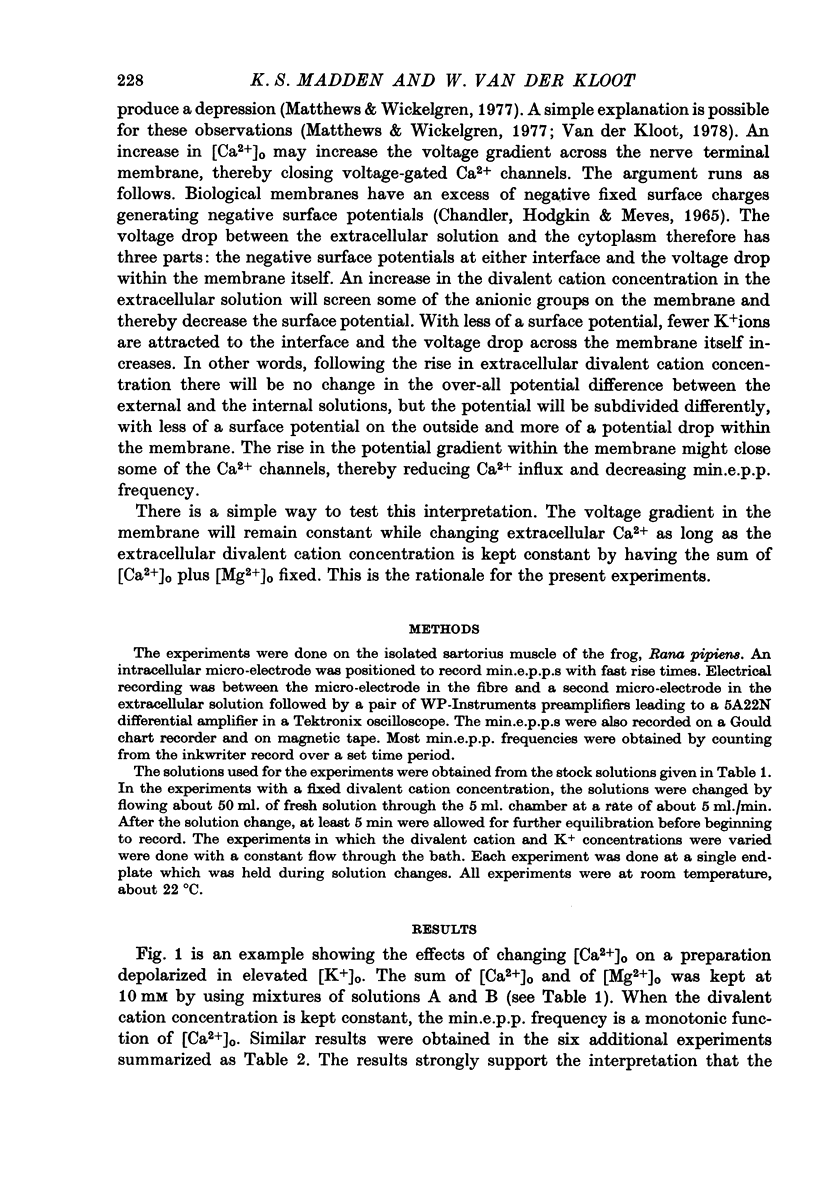Abstract
1. When motor nerve terminals are slightly depolarized with increased [K+]o, progressive increases in [Ca2+]o raise min.e.p.p. frequencies until a maximum is reached; further increases then produce a depression (Cook & Quastel, 1973; Matthews & Wickelgren, 1977). 2. Increases in [Mg2+]o also produce the depression. 3. It has been suggested that the depression results from this sequence of events: (a) the divalent cations screen the fixed negative surface charges on the outer face of the nerve terminal, which (b) decreases the negativity of the surface potential, which (c) increases the voltage gradient within the membrane itself, which (d) tends to shut depolarization-gated channels for Ca2+ entry, which (e) decreases min.e.p.p. frequency. 4. In agreement with the interpretation, in frog neuromuscular junctions slightly depolarized with 11 mM-[K+]o, min.e.p.p. frequency is a monotonically increasing function of [Ca2+]o, as long as the sum of [Ca2+]o plus [Mg2+]o is kept constant. 5. The decrease in min.e.p.p. frequency caused by raising [Mg2+]o by 5 mM can be counterbalanced by raising [K+]o by about 9 mM. Using the Grahame equation (1947), assuming that the elevated divalent cations act solely by screening and have no effect on conductance, the negative surface charge is estimated to be roughly 1 electronic charge/75 A2.
Full text
PDF





Selected References
These references are in PubMed. This may not be the complete list of references from this article.
- Chandler W. K., Hodgkin A. L., Meves H. The effect of changing the internal solution on sodium inactivation and related phenomena in giant axons. J Physiol. 1965 Oct;180(4):821–836. doi: 10.1113/jphysiol.1965.sp007733. [DOI] [PMC free article] [PubMed] [Google Scholar]
- Cooke J. D., Quastel D. M. The specific effect of potassium on transmitter release by motor nerve terminals and its inhibition by calcium. J Physiol. 1973 Jan;228(2):435–458. doi: 10.1113/jphysiol.1973.sp010094. [DOI] [PMC free article] [PubMed] [Google Scholar]
- GRAHAME D. C. The electrical double layer and the theory of electrocapillarity. Chem Rev. 1947 Dec;41(3):441–501. doi: 10.1021/cr60130a002. [DOI] [PubMed] [Google Scholar]
- Hurlbut W. P., Longenecker H. B., Jr, Mauro A. Effects of calcium and magnesium on the frequency of miniature end-plate potentials during prolonged tetanization. J Physiol. 1971 Dec;219(1):17–38. doi: 10.1113/jphysiol.1971.sp009647. [DOI] [PMC free article] [PubMed] [Google Scholar]
- Matthews G., Wickelgren W. O. On the effect of calcium on the frequency of miniature end-plate potentials at the frog neuromuscular junction. J Physiol. 1977 Mar;266(1):91–101. doi: 10.1113/jphysiol.1977.sp011757. [DOI] [PMC free article] [PubMed] [Google Scholar]
- McLaughlin S. G., Szabo G., Eisenman G. Divalent ions and the surface potential of charged phospholipid membranes. J Gen Physiol. 1971 Dec;58(6):667–687. doi: 10.1085/jgp.58.6.667. [DOI] [PMC free article] [PubMed] [Google Scholar]
- Muller R. U., Finkelstein A. The electrostatic basis of Mg++ inhibition of transmitter release. Proc Natl Acad Sci U S A. 1974 Mar;71(3):923–926. doi: 10.1073/pnas.71.3.923. [DOI] [PMC free article] [PubMed] [Google Scholar]


